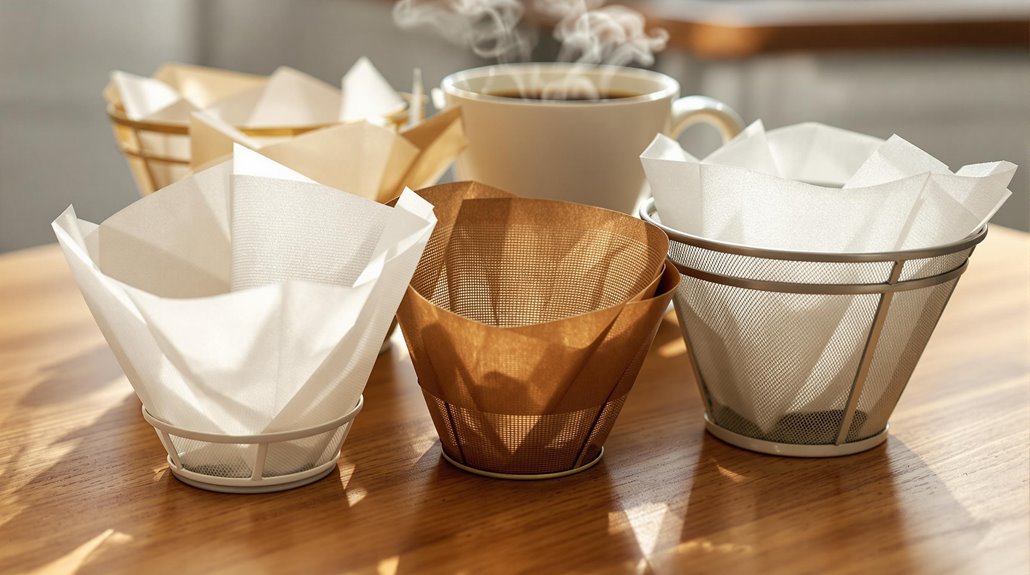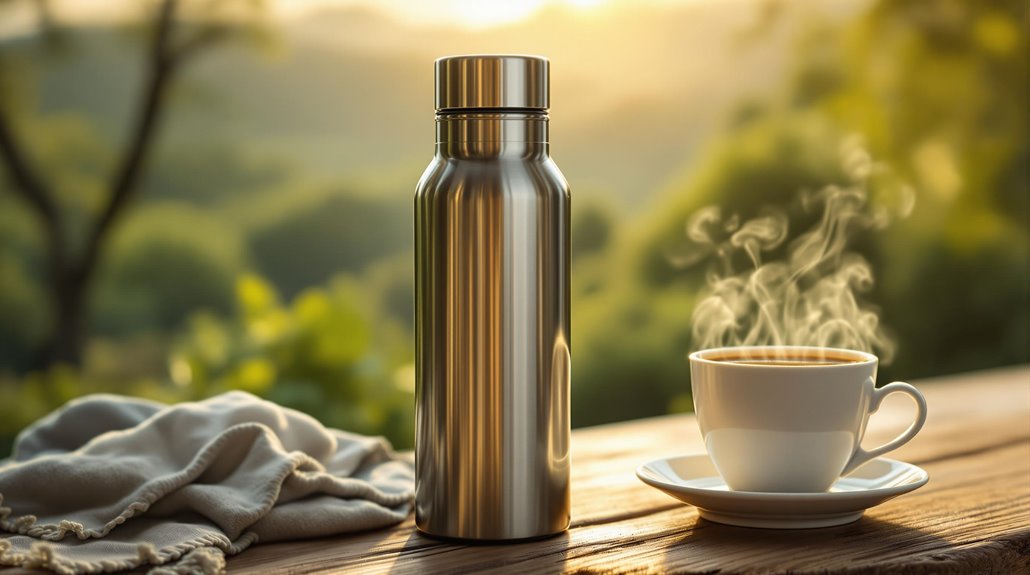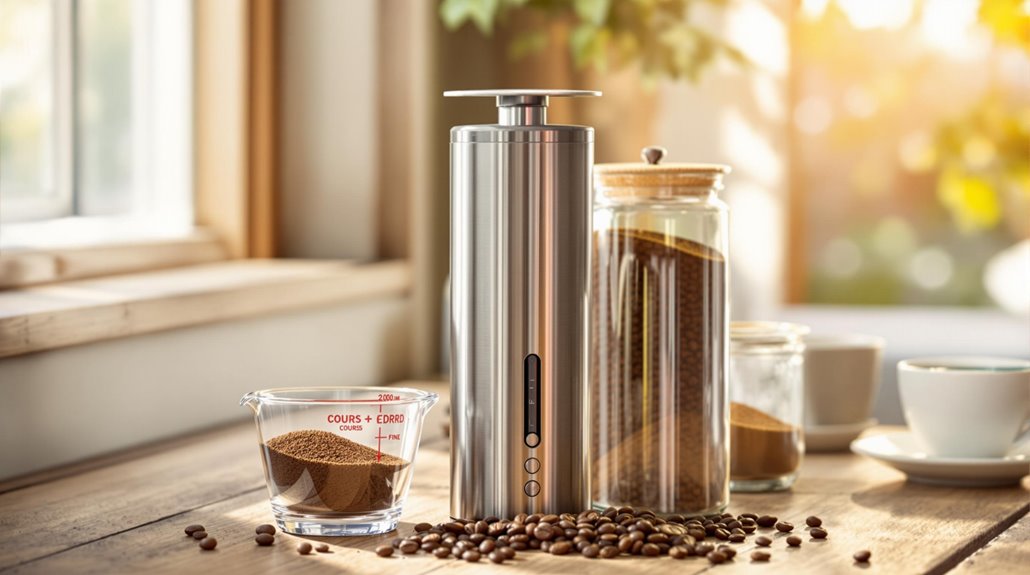







Maintaining your espresso machine isn't just about keeping it clean; it's essential for ensuring your coffee tastes just right. You should start with daily routines like flushing the group head and wiping the portafilter, but that's just the tip of the iceberg. Using the right cleaning products can make a significant difference, and knowing what to check monthly can prevent larger issues down the line. Curious about the specific steps and best practices to keep your machine in top shape? There's more to explore that can make your daily brewing experience even better.
Key Takeaways
- Perform daily maintenance tasks like backflushing, portafilter cleaning, and steam wand purging to ensure optimal machine performance.
- Use manufacturer-recommended cleaning products and avoid vinegar to prevent unwanted flavors in your espresso.
- Conduct monthly checks, including replacing water filters and inspecting for calcium deposits, to maintain water quality.
- Schedule annual professional maintenance to inspect and replace critical components for long-term machine reliability.
- Test water hardness regularly and use softened or filtered water to minimize scale buildup and improve espresso flavor.
Daily Maintenance Tasks
To keep your espresso machine in excellent condition, daily maintenance tasks are essential. Start each day by performing a quick flush of the group head for 1-3 seconds after each shot. This short burst helps remove coffee grounds and oils, preventing buildup that can affect flavor. After using the portafilter, make sure to wipe it clean immediately. This simple step maintains hygiene and guarantees your shots remain first-rate.
Next, implement a quick water backflush using a backflush blank in the portafilter. This daily ritual removes internal residue and keeps your machine operating smoothly. Don't forget to wipe the steam wand! Purge it for 1-2 seconds before and after steaming milk to eliminate any blockages and maintain food safety.
Lastly, while it may seem minor, don't overlook the exterior. Wipe down the machine occasionally to keep it clean and prevent grime accumulation. By committing to these daily tasks, you'll prolong the life of your espresso machine and enhance the quality of your brews. So, invest a little time each day—your espresso deserves it!
Cleaning Products to Use
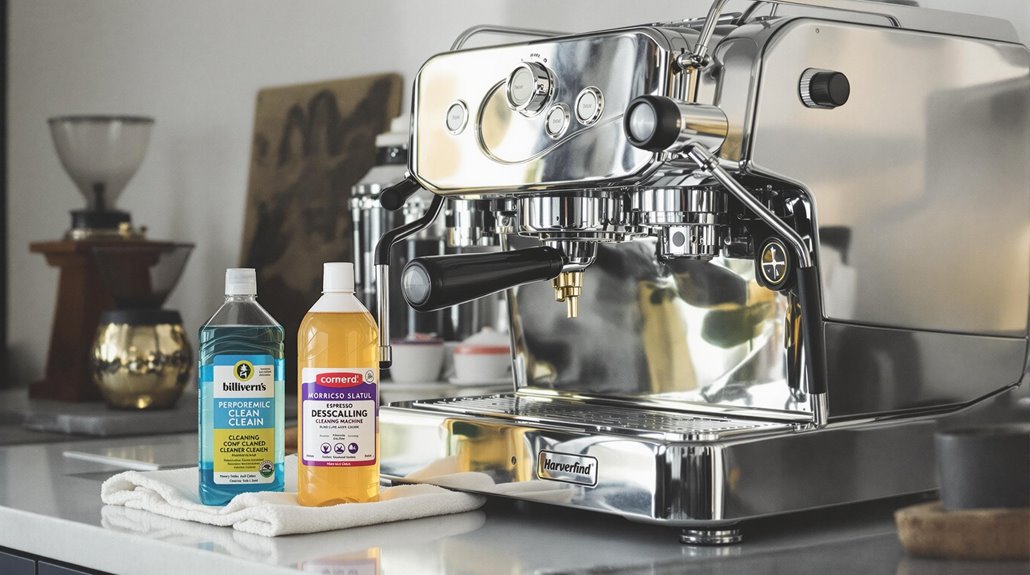
When it comes to cleaning your espresso machine, always stick to manufacturer-recommended products like Urnex Cafiza to prevent damage and guarantee thorough cleaning. While some eco-friendly options exist, like a vinegar and water mix, they require meticulous rinsing to avoid any unwanted flavors in your brew. Prioritizing the right cleaning agents not only maintains hygiene but also preserves the integrity of your coffee experience.
Manufacturer-Recommend Cleaning Products
Using the right cleaning products is essential for maintaining your espresso machine's performance and longevity. Manufacturer-recommended products like Urnex Cafiza and PuroCaf are specifically formulated for espresso machine cleaning and are your best bet for effective results. These coffee detergents break down stubborn coffee oils and residues without harming machine components, guaranteeing you achieve peak flavor while preserving your equipment.
Avoid using vinegar or non-espresso-specific detergents, as they can leave behind unpleasant odors and flavors that will ruin your coffee experience. Always follow the manufacturer's instructions for cleaning product usage to not only enhance cleaning and maintenance but also to maintain your warranty.
After using these machine detergents, make sure to rinse thoroughly. Residual flavors from cleaning products can negatively impact the taste of your espresso, so a thorough rinse is vital. By selecting the right cleaning products and adhering to proper usage, you'll keep your espresso machine in peak condition, prolong its lifespan, and guarantee each cup of coffee is a delightful experience. Your espresso deserves the best, and so do you!
Eco-Friendly Cleaning Alternatives
Eco-friendly cleaning alternatives offer effective ways to maintain your espresso machine while minimizing environmental impact. A simple mixture of vinegar and water serves as a powerful descaling agent, dissolving mineral buildup without the need for harsh chemicals. Just remember to rinse thoroughly afterward to avoid any lingering flavors that could affect your brew. For a greener choice, consider biodegradable, non-toxic cleaners like Cafetto Eco or Puly Caff Eco; they clean effectively while supporting sustainability.
Baking soda is another excellent option as a gentle abrasive. Use it to scrub removable parts, such as portafilters and steam wands, ensuring you rinse well to maintain water quality. Alternatively, lemon juice mixed with water can effectively tackle calcium deposits, providing a natural solution when used in moderation.
Lastly, switch to reusable microfiber cloths and brushes instead of disposable tools. This small change not only reduces waste but also contributes to a more eco-friendly cleaning routine. By integrating these practices, you'll keep your espresso machine in top shape while doing your part for the environment.
Monthly Maintenance Checklist
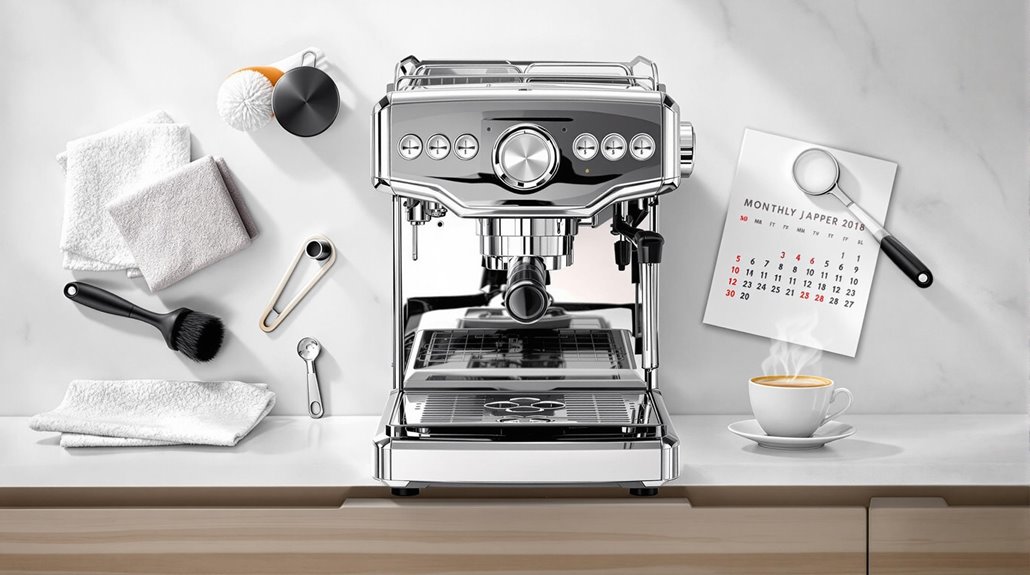
Each month, you need to check and replace your inline water filtration cartridges to guarantee excellent water quality and prevent calcium deposits from wreaking havoc on your machine. Regularly inspecting for these deposits not only keeps your espresso tasting great but also extends the life of your equipment. Staying on top of this task is vital for maintaining the performance you demand from your espresso machine.
Check Water Filter Cartridges
Maintaining the integrity of your espresso machine's water supply depends on the efficiency of its inline water filtration cartridges. These cartridges play a key role in providing clean water, free from impurities that could affect the taste of your espresso. Monthly checks are necessary to verify that the filtration system is working at its best.
Begin by examining the cartridges for any indications of wear or obstructions. If you observe a decrease in water flow or if the water quality appears compromised, it's time to replace them. Keep in mind, faulty filters can result in chemical flavors in your coffee, disrupting the fine balance of flavors you aim for.
Furthermore, watch for any calcium buildup inside the machine, as this can suggest that your filtration system isn't performing effectively. Consistently maintaining the water softening system filter cartridges is also essential; they guarantee that the water used in your espresso machine stays perfect for brewing.
Inspect for Calcium Deposits
As you explore into your monthly maintenance routine, checking for calcium deposits is crucial for the longevity and performance of your espresso machine. Start by inspecting the inline water filtration cartridges for any signs of calcium deposits, which can indicate ineffective filtration. Next, examine the steam wand and boiler for white, chalky buildup; this signals calcium accumulation that requires immediate descaling.
Monitor your water hardness levels using a test kit, ensuring they remain within the suggested range of 35-85 ppm. High water hardness can lead to significant scale buildup, adversely affecting your machine's efficiency and the quality of your espresso. Don't forget to check the group head and dispersion screen for any scale buildup as well, since this can hinder water flow and compromise your brew.
If you do spot calcium deposits, it's critical to replace the water softening system filter cartridges promptly. This proactive step prevents machine damage and maintains ideal performance. By diligently inspecting for calcium deposits, you're not only caring for your espresso machine but also ensuring that every cup you brew is rich in flavor and quality.
Annual Maintenance Duties
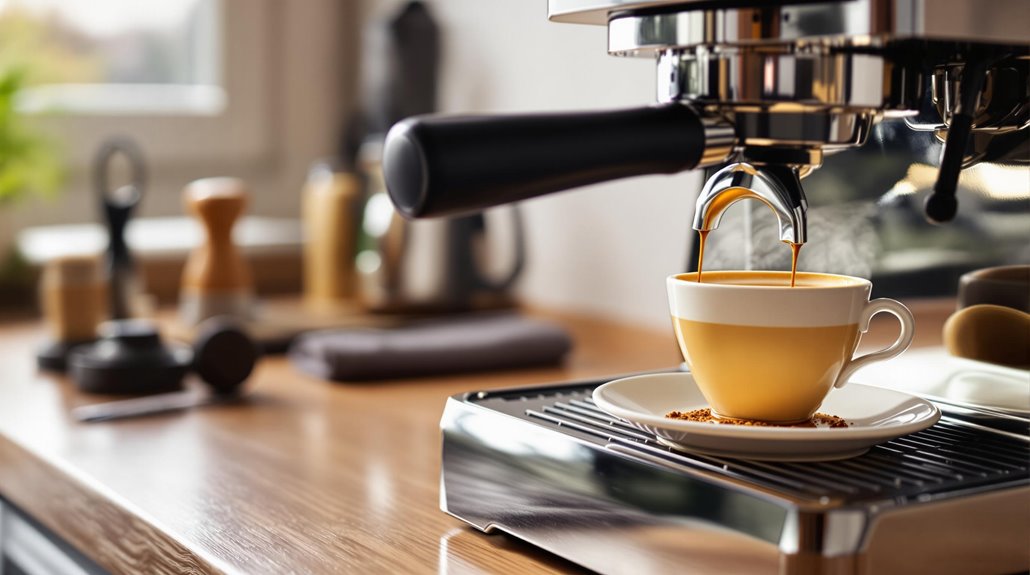
Annual maintenance duties for your espresso machine are essential for achieving peak performance and longevity. Start by replacing the steam and hot water valve or its rings to prevent leaks. This simple step guarantees that your machine delivers steam and hot water at ideal levels for the perfect brew. Next, inspect and replace the expansion valve yearly; a faulty valve can lead to temperature loss that affects extraction quality.
Don't overlook the anti-suction valve and brew actuator bearing. These components are key for consistent espresso extraction, and replacing them annually will help maintain the integrity of your shots. Regularly examine the waste pipe and portafilter baskets, replacing them if they're worn or damaged, as this can directly impact your machine's functionality.
Finally, scheduling professional maintenance each year is indispensable. Professionals can address internal components that you might miss, guaranteeing everything runs smoothly and extending your machine's lifespan. By adhering to these annual maintenance duties, you'll not only maximize your espresso machine's performance but also enhance your overall coffee experience. Remember, a well-maintained machine is the key to exceptional espresso!
Descaling Your Espresso Machine
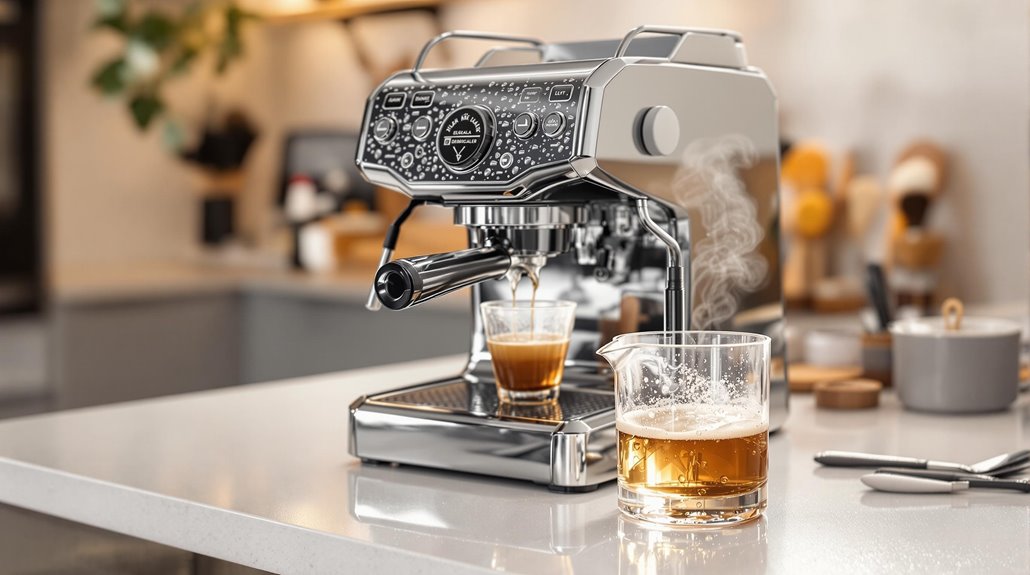
Descaling your espresso machine is essential for maintaining its peak performance and flavor quality. Over time, calcium buildup accumulates in the boiler, affecting espresso pressure and consistency. This scale can lead to burnt, bitter flavors and even damage your machine's internal components. To combat this, you'll need a dedicated descaling agent, as vinegar can taint the flavor of your brews.
Follow your machine's manual for specific descaling instructions and recommended frequency. Annual descaling is vital, even if you use good filtration, as small amounts of calcium inevitably gather over time. Regular descaling not only prevents pipe blockages but also saves you from costly repairs down the line.
The process typically involves mixing the descaling solution with water, allowing it to circulate through the machine for the recommended time, and then rinsing thoroughly. This step is critical for ensuring ideal machine performance. By committing to this routine, you extend your machine's lifespan and preserve the quality of your espresso. Remember, using filtered or softened water can greatly minimize future scale buildup, further enhancing your espresso experience.
Water Quality Considerations
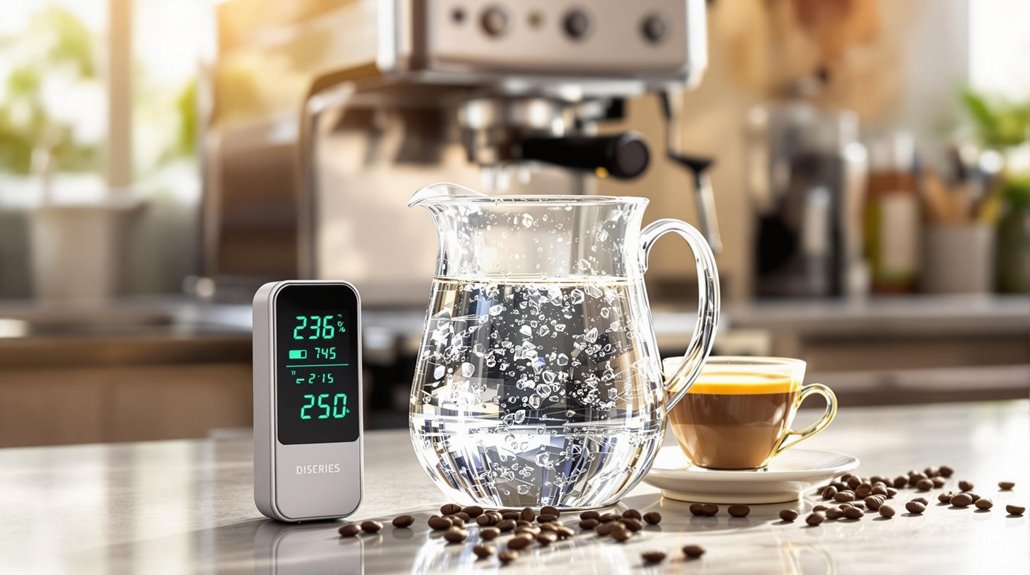
Water quality is vital for the longevity and performance of your espresso machine. You need to use filtered, softened water with a total hardness of 35-85 ppm to prevent scale buildup that can lead to expensive repairs. Regularly testing your water hardness, even if you have a softening system, is essential to guarantee your machine operates at its best.
Importance of Water Quality
When you think about maintaining your espresso machine, the quality of the water you use is vital for its longevity and performance. Poor water quality leads to scale buildup, which is the leading cause of espresso machine failure. This buildup can result in costly repairs and greatly impact the flavor of your espresso.
To prevent these issues, always use filtered, softened water. Aim for a total hardness of 35-85 ppm to secure peak performance. Even if you have whole-home softening systems, don't forget to test your water regularly. They might not provide adequate protection against hard water, which can wreak havoc on your machine.
For long-term protection, consider installing an in-line or under-sink water softening and filtration system. This investment, usually around $250, pays off by extending the life of your equipment. If you're dealing with extremely hard water or using your machine in a commercial setting, opt for a two-stage commercial filtration system to guarantee consistent water quality. Ultimately, prioritizing water quality is key for achieving the perfect espresso while safeguarding your machine from unnecessary damage.
Testing Water Hardness
Maintaining the right water hardness is essential for keeping your espresso machine running smoothly and delivering exceptional coffee. To achieve peak performance, you should regularly test your water hardness using a reliable test kit. Aim for levels between 35-85 ppm, which is ideal for your machine. If your water exceeds these levels, it's time to take action.
Using filtered or softened water can greatly prevent scale buildup, which can damage your machine's internal components over time. If you notice high mineral content, consider installing an in-line or under-sink water softening and filtration system. For extremely hard water or if you're operating in a commercial setting, a two-stage commercial filtration system is an excellent investment to protect your espresso machine from scale-related issues.
Even if you have a whole-home softening system, don't forget to monitor your water quality quarterly. These systems may not always maintain necessary hardness levels, so regular checks are vital. By staying proactive about your water hardness, you guarantee your espresso machine not only lasts longer but also consistently delivers rich, flavorful coffee that you—and your customers—will love.
Post-Shot Cleaning Routine
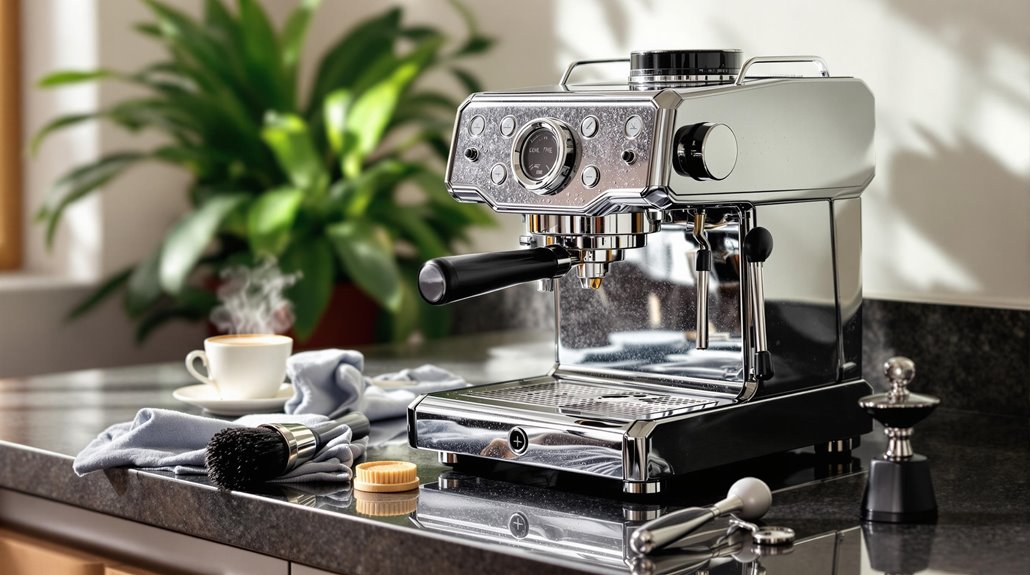
A thorough post-shot cleaning routine is essential for preserving the integrity of your espresso machine and ensuring each brew delivers peak flavor. After extracting your shot, immediately knock out the spent puck to prevent leftover oils and grounds from sticking to the filter screen and portafilter basket. This step is vital, as residue can compromise the next extraction.
Next, rinse the portafilter under running water for 2-3 seconds. This quick rinse cleans the filter screen and basket, ensuring no residue remains to taint future shots. Follow this up by wiping the filter screen and portafilter with a clean rag, effectively removing any lingering oils or grounds that could affect flavor.
Don't forget about the steam wand. Wipe it down with a damp rag right after use to prevent milk from drying and solidifying, which can lead to clogs and a less effective steam function. By keeping the filter screen, portafilter, and steam wand clean after every shot, you maintain ideal flavor and machine readiness, ensuring every cup is as exquisite as it should be.
Deep Cleaning Techniques
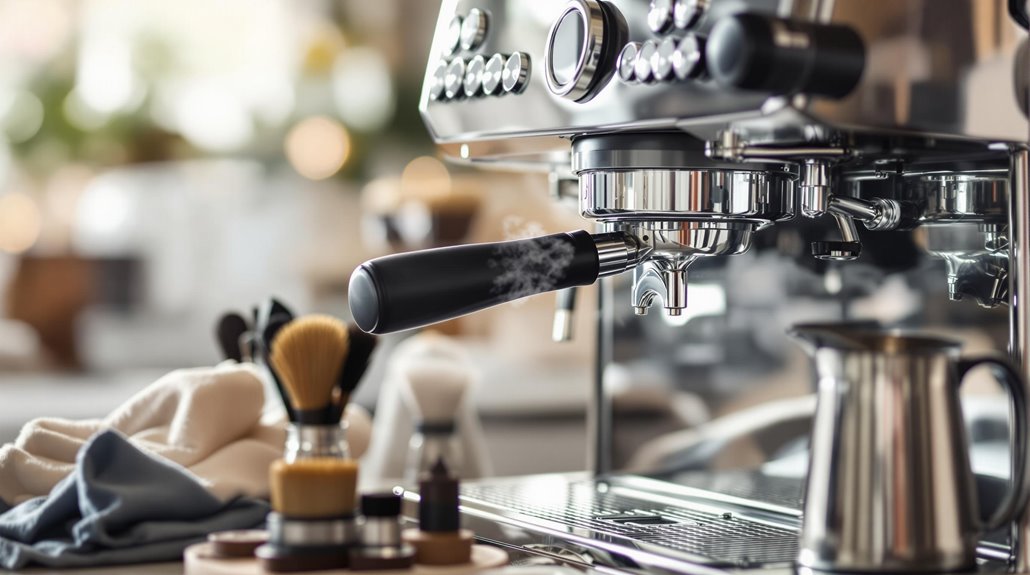
Keeping your espresso machine in top shape goes beyond the daily cleaning routine; it requires a commitment to deep cleaning. You'll want to perform this vital task weekly, using an espresso cleaner to tackle those stubborn oils and grounds that daily maintenance might miss.
If your machine has a valve system, backflush it with a blank screen and espresso cleaner. Run water for 10 seconds, pause for 5 seconds, and repeat this process three times. This guarantees that all internal components are thoroughly cleansed. For machines without a valve system, manually remove the dispersion screen and portafilter, soaking them along with the steam wand in a water/cleaner solution for 10-15 minutes.
While you're at it, scrub the group head with a damp rag and espresso cleaner to eliminate any lingering residue. After deep cleaning, don't forget to rinse all parts thoroughly. This step is key to prevent any residual flavors from affecting your future espresso shots. By committing to these deep cleaning techniques, you'll guarantee that each cup of espresso you brew is as rich and flavorful as it should be.
Steam Wand Care
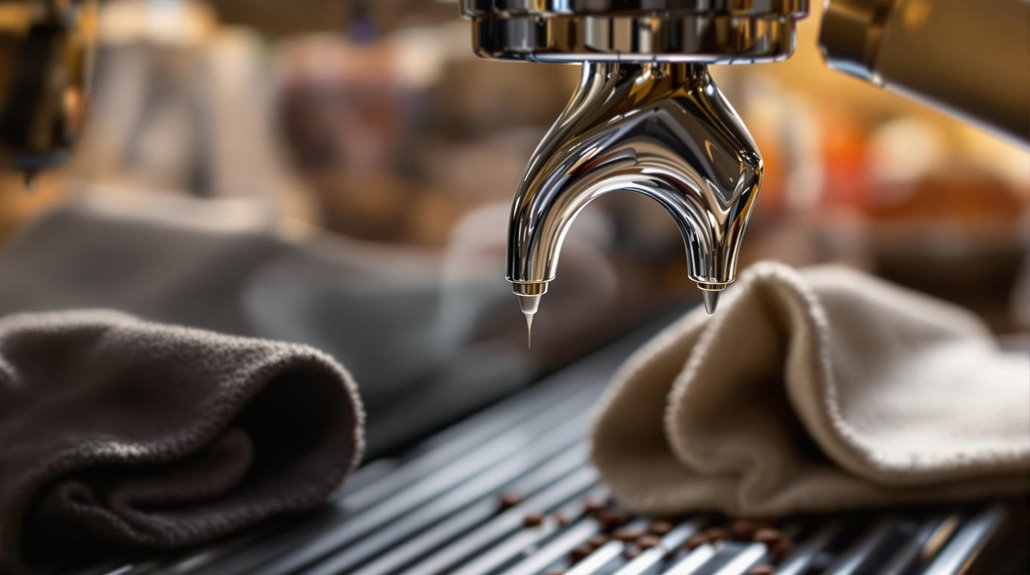
Amidst the daily hustle of brewing the perfect espresso, the steam wand often becomes an overlooked component in your machine's performance. To guarantee your steam wand operates at its best, start by purging it for 1-2 seconds before and after each use. This simple step prevents blockages and keeps the steam pressure consistent, which is vital for frothing milk effectively.
After steaming, grab a damp cloth and wipe the steam wand immediately to remove any milk residue. This quick action helps prevent buildup that could hinder performance. Every six months, soak the steam wand in a cleaning solution like Rinza to dissolve stubborn milk deposits that regular cleaning might miss.
If you notice any crusty milk in the steam tip holes, use a paperclip to carefully clear them out. Regular inspection of the steam wand for leaks or damage is essential; even a small issue can impact steam pressure and functionality. By dedicating a little time to your steam wand care, you'll guarantee that it remains a powerful tool in your espresso-making arsenal, helping you create café-quality beverages at home.
Maintenance Scheduling Tips
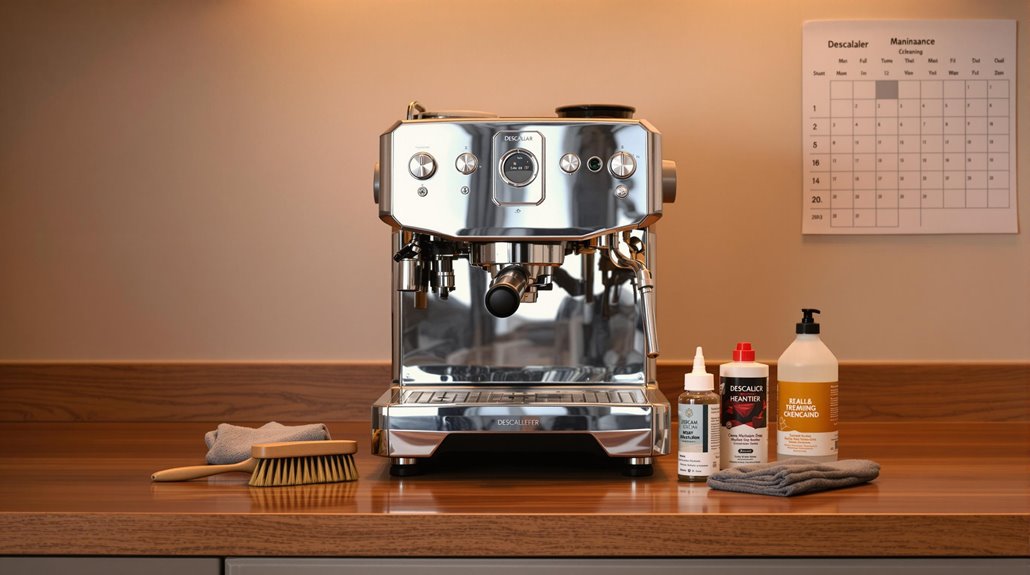
Regularly scheduling maintenance for your espresso machine is vital to guaranteeing its longevity and peak performance. Start by integrating daily cleaning tasks into your staff schedules. This way, you'll cultivate consistent maintenance habits that prevent buildup and keep your machine operating smoothly. Each day, allocate time to check the cleanliness of the portafilter and group head, making sure they're free from coffee oils and residues.
Next, set calendar reminders for monthly and annual maintenance checks. These reminders are critical for replacing small parts like shower screens and portafilter baskets every 1-2 months. This simple task helps prevent leaks and maintains top-tier performance.
Don't forget to prioritize scheduling professional maintenance services with your distributors or manufacturers annually. Complex repairs and thorough inspections by experts guarantee that every component of your machine functions at its best.
Disclosure: As an Amazon Associate, I earn from qualifying purchases.





